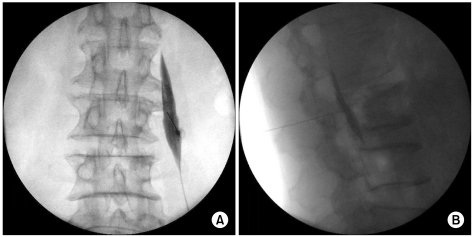Korean J Pain.
2012 Apr;25(2):116-120. 10.3344/kjp.2012.25.2.116.
Psoas Compartment Blockade in a Laterally Herniated Disc Compressing the Psoas Muscle: A Case Report
- Affiliations
-
- 1Department of Anesthesiology and Pain Medicine, Seoul National University Bundang Hospital, Seongnam, Korea.
- 2Department of Anesthesiology and Pain Medicine, Seoul National University Hospital, Seoul, Korea. soo02@snu.ac.kr
- 3Department of Anesthesiology and Pain Medicine, Jeju National University Hospital, Jeju, Korea.
- KMID: 1778997
- DOI: http://doi.org/10.3344/kjp.2012.25.2.116
Abstract
- A psoas compartment block has been used to provide anesthesia for orthopedic surgical procedures and analgesia for post-operative pain. Currently, this block is advocated for relieving pain in the lower extremity and pelvic area resulting from various origins. We report a case of a 69-year-old male patient who had gait abnormality with posterior pelvic and hip pain, which were both aggravated by hip extension. From the magnetic resonance image, the patient was found to have a laterally herniated intervertebral disc at the L2/3 level, which compressed the right psoas muscle. This was thought to be the origin of the pain, so a psoas compartment block was performed using 0.25% chirocaine with triamcinolone 5mg, and the pain in both the pelvis and hip were relieved.
Keyword
MeSH Terms
Figure
Reference
-
1. Bogduk N, Pearcy M, Hadfield G. Anatomy and biomechanics of psoas major. Clin Biomech (Bristol, Avon). 1992; 7:109–119.
Article2. Travell JG, Simons DG. Myofascial pain and dysfunction: the trigger point manual. 1983. Baltimore: Lippincott Williams & Wilkins;p. 89–109.3. Brown DL. Psoas compartment block. Atlas of regional anesthesia. 2006. 3rd ed. Philadelphia: Elsevier/Saunders;p. 95–96.4. Chayen D, Nathan H, Chayen M. The psoas compartment block. Anesthesiology. 1976; 45:95–99. PMID: 937760.
Article5. Chelly JE, Casati A, Al-Samsam T, Coupe K, Criswell A, Tucker J. Continuous lumbar plexus block for acute post-operative pain management after open reduction and internal fixation of acetabular fractures. J Orthop Trauma. 2003; 17:362–367. PMID: 12759641.
Article6. Lee WJ, Sung NS, Kim C. Effect of psoas compartment block in low extremity pain from stomach cancer: a case report. J Korean Pain Soc. 1992; 5:113–116.7. Lansdown AJ, Downing A, Roberts AW, Martin D. Psoas abscess formation in suboptimally controlled diabetes mellitus. Case Report Med. 2011; 2011:249325. PMID: 21811508.
Article8. Wada Y, Yanagihara C, Nishimura Y. Bilateral iliopsoas hematomas complicating anticoagulant therapy. Intern Med. 2005; 44:641–643. PMID: 16020897.
Article9. Yang WT, Yeo W, Metreweli C. Imaging of iliopsoas metastasis. Clin Radiol. 1999; 54:85–89. PMID: 10050734.
Article10. Avery GR. Metastatic adenocarcinoma masquerading as a psoas abscess. Clin Radiol. 1988; 39:319–320. PMID: 3396286.11. Hood RS. Far lateral lumbar disc herniations. Neurosurg Clin N Am. 1993; 4:117–124. PMID: 8428146.
Article12. Dangaria TR, Naesh O. Changes in cross-sectional area of psoas major muscle in unilateral sciatica caused by disc herniation. Spine (Phila Pa 1976). 1998; 23:928–931. PMID: 9580961.
Article13. Trummer M, Flaschka G, Unger F, Eustacchio S. Lumbar disc herniation mimicking meralgia paresthetica: case report. Surg Neurol. 2000; 54:80–81. PMID: 11024511.
Article14. Sajko S, Stuber K. Psoas Major: a case report and review of its anatomy, biomechanics, and clinical implications. J Can Chiropr Assoc. 2009; 53:311–318. PMID: 20037696.15. Torres GM, Cernigliaro JG, Abbitt PL, Mergo PJ, Hellein VF, Fernandez S, et al. Iliopsoas compartment: normal anatomy and pathologic processes. Radiographics. 1995; 15:1285–1297. PMID: 8577956.
Article16. Mannion S. Psoas compartment block. Contin Educ Anaesth Crit Care Pain. 2007; 7:162–166.
Article
- Full Text Links
- Actions
-
Cited
- CITED
-
- Close
- Share
- Similar articles
-
- Psoas sign: a reevaluation
- Non-Hodgkin Lymphoma Occurred in Psoas Muscle
- Psoas Abscess Complicated from Psoas Compartment Block: A case report
- Effect of Psoas Compartment Block in Low Extremity Neuropathic Cancer Pain: Three case reports
- A Study of the Depth from the Skin to the Psoas Compartment under C-arm Guidance



